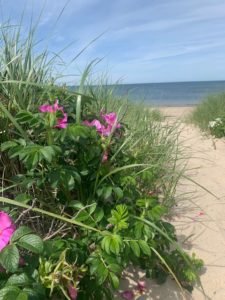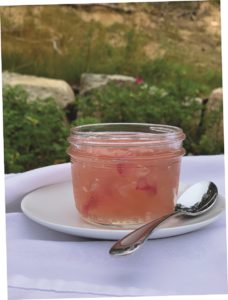The more I live into my life in Truro, the more amazed I am at the food I can find around me if I really look. I’m not talking about what’s at the Stop & Shop (though I do find things to eat there from time to time). What I’m talking about are the foods that grow wild along the trails and marshes and the old rail bed.
I discovered them slowly, only as we began living at the cottage for longer and longer stretches. I noticed cars stopped along Old County Road in midsummer. Those folks combed over the brambles with buckets in hand, harvesting black raspberries. (The harvest looked just like the blackberries I grew up with, but the foragers insisted these were different — who am I to contradict them?) Later in the summer, I observed two women with a sheet, a stepladder, and clippers. Again, I pulled over. I wouldn’t describe their response to my inquiry as friendly, but they did let me know that they were harvesting elderberries.

Since landing here full-time, I’ve learned a ton about foraging, much of it from my friend Ingrid, who never saw a wild plant she didn’t like. She has taught me about all the wild lamb’s quarters, stinging nettles, purslane, dandelion greens, elderberry flowers, rose hips, sea beans, and grape leaves waiting to be harvested. Another friend, Joan, gives us a jar of beach plum cordial every year — she makes it with plums that her grandchildren forage. We hoard the ruby-filled jar until the holiday season and then swirl spoonfuls into glasses of champagne to make the Sparkling Plum. And there are mushrooms everywhere. Like most Americans, I’m scared by wild mushrooms. But my colleague, Vida, has promised to show me the ropes. She’s not afraid — she’s Lithuanian.
I’ve long wanted to forage the rugosa roses that grow on the dunes. Years ago, I was given a jar of rose petal jam and I can still remember the wild, floral aroma it released as I spread it across warm scones. Shortly afterward, I copied down a recipe from an old cookbook with a forbidding-sounding title, something like British Cookery. It’s been waiting patiently in my kitchen notebook ever since.
That recipe came to mind on a recent walk across Bound Brook Island to the bay. Just below the Hatch House, on the far side of the island, there’s a sandy path that takes me through a gorgeous sweet-smelling field of dune roses. I want to capture that moment in a jar, so I fill my pockets with pink and white blossoms and head back to the cottage.
I remove the petals from the rest of the flower and pick off all the critters I can find. Then I gently wash them and go in search of the recipe and the few pantry items I’ll need. I simmer the petals in water and am disappointed to see them turn a sad brown hue. The jam I remembered was a lovely, vibrant pink. But when I add lemon juice, the natural color of the roses reappears.
In less than an hour, I have three jars of beautiful pink jam that smells like a field of roses on an early summer day.
Dune Rose Petal Jam

Makes 3 half pints
1½ cups water
2 oz. wild rose petals (about 2 cups lightly packed)
2 cups sugar, divided
3 Tbsp. fresh lemon juice
1 tsp. fruit pectin
Shake any bugs out of the roses, pick the petals into a colander, and rinse them gently.
Bring the water to a gentle simmer and add the clean rose petals. Simmer for 10 minutes.
Add 1¾ cups of the sugar and stir until it dissolves. Add the lemon juice and simmer for an additional 10 minutes.
In a small bowl, combine the pectin and the remaining ¼ cup of sugar. Slowly sprinkle the sugar-pectin mix into the simmering petals, stirring all the while so that the pectin doesn’t clump.
Simmer for an additional 20 minutes. The jam may be kept in the refrigerator for 2 months or frozen for a year.
